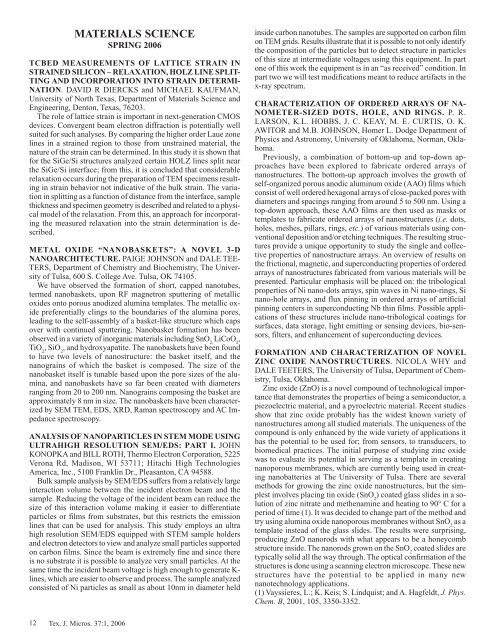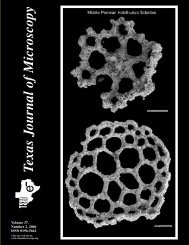Texas Journal of Microscopy Texas Journal of Microscopy
Texas Journal of Microscopy Texas Journal of Microscopy
Texas Journal of Microscopy Texas Journal of Microscopy
Create successful ePaper yourself
Turn your PDF publications into a flip-book with our unique Google optimized e-Paper software.
MATERIALS SCIENCE<br />
SPRING 2006<br />
TCBED MEASUREMENTS OF LATTICE STRAIN IN<br />
STRAINED SILICON – RELAXATION, HOLZ LINE SPLIT-<br />
TING AND INCORPORATION INTO STRAIN DETERMI-<br />
NATION. DAVID R DIERCKS and MICHAEL KAUFMAN,<br />
University <strong>of</strong> North <strong>Texas</strong>, Department <strong>of</strong> Materials Science and<br />
Engineering, Denton, <strong>Texas</strong>, 76203.<br />
The role <strong>of</strong> lattice strain is important in next-generation CMOS<br />
devices. Convergent beam electron diffraction is potentially well<br />
suited for such analyses. By comparing the higher order Laue zone<br />
lines in a strained region to those from unstrained material, the<br />
nature <strong>of</strong> the strain can be determined. In this study it is shown that<br />
for the SiGe/Si structures analyzed certain HOLZ lines split near<br />
the SiGe/Si interface; from this, it is concluded that considerable<br />
relaxation occurs during the preparation <strong>of</strong> TEM specimens resulting<br />
in strain behavior not indicative <strong>of</strong> the bulk strain. The variation<br />
in splitting as a function <strong>of</strong> distance from the interface, sample<br />
thickness and specimen geometry is described and related to a physical<br />
model <strong>of</strong> the relaxation. From this, an approach for incorporating<br />
the measured relaxation into the strain determination is described.<br />
METAL OXIDE “NANOBASKETS”: A NOVEL 3-D<br />
NANOARCHITECTURE. PAIGE JOHNSON and DALE TEE-<br />
TERS, Department <strong>of</strong> Chemistry and Biochemistry, The University<br />
<strong>of</strong> Tulsa, 600 S. College Ave. Tulsa, OK 74105.<br />
We have observed the formation <strong>of</strong> short, capped nanotubes,<br />
termed nanobaskets, upon RF magnetron sputtering <strong>of</strong> metallic<br />
oxides onto porous anodized alumina templates. The metallic oxide<br />
preferentially clings to the boundaries <strong>of</strong> the alumina pores,<br />
leading to the self-assembly <strong>of</strong> a basket-like structure which caps<br />
over with continued sputtering. Nanobasket formation has been<br />
observed in a variety <strong>of</strong> inorganic materials including SnO 2, LiCoO 2 ,<br />
TiO 2 , SiO 2 , and hydroxyapatite. The nanobaskets have been found<br />
to have two levels <strong>of</strong> nanostructure: the basket itself, and the<br />
nanograins <strong>of</strong> which the basket is composed. The size <strong>of</strong> the<br />
nanobasket itself is tunable based upon the pore sizes <strong>of</strong> the alumina,<br />
and nanobaskets have so far been created with diameters<br />
ranging from 20 to 200 nm. Nanograins composing the basket are<br />
approximately 8 nm in size. The nanobaskets have been characterized<br />
by SEM TEM, EDS, XRD, Raman spectroscopy and AC Impedance<br />
spectroscopy.<br />
ANALYSIS OF NANOPARTICLES IN STEM MODE USING<br />
ULTRAHIGH RESOLUTION SEM/EDS: PART I. JOHN<br />
KONOPKA and BILL ROTH, Thermo Electron Corporation, 5225<br />
Verona Rd, Madison, WI 53711; Hitachi High Technologies<br />
America, Inc., 5100 Franklin Dr., Pleasanton, CA 94588.<br />
Bulk sample analysis by SEM/EDS suffers from a relatively large<br />
interaction volume between the incident electron beam and the<br />
sample. Reducing the voltage <strong>of</strong> the incident beam can reduce the<br />
size <strong>of</strong> this interaction volume making it easier to differentiate<br />
particles or films from substrates, but this restricts the emission<br />
lines that can be used for analysis. This study employs an ultra<br />
high resolution SEM/EDS equipped with STEM sample holders<br />
and electron detectors to view and analyze small particles supported<br />
on carbon films. Since the beam is extremely fine and since there<br />
is no substrate it is possible to analyze very small particles. At the<br />
same time the incident beam voltage is high enough to generate Klines,<br />
which are easier to observe and process. The sample analyzed<br />
consisted <strong>of</strong> Ni particles as small as about 10nm in diameter held<br />
12 Tex. J. Micros. 37:1, 2006<br />
inside carbon nanotubes. The samples are supported on carbon film<br />
on TEM grids. Results illustrate that it is possible to not only identify<br />
the composition <strong>of</strong> the particles but to detect structure in particles<br />
<strong>of</strong> this size at intermediate voltages using this equipment. In part<br />
one <strong>of</strong> this work the equipment is in an “as received” condition. In<br />
part two we will test modifications meant to reduce artifacts in the<br />
x-ray spectrum.<br />
CHARACTERIZATION OF ORDERED ARRAYS OF NA-<br />
NOMETER-SIZED DOTS, HOLE, AND RINGS. P. R.<br />
LARSON, K.L. HOBBS, J. C. KEAY, M. E. CURTIS, O. K.<br />
AWITOR and M.B. JOHNSON, Homer L. Dodge Department <strong>of</strong><br />
Physics and Astronomy, University <strong>of</strong> Oklahoma, Norman, Oklahoma.<br />
Previously, a combination <strong>of</strong> bottom-up and top-down approaches<br />
have been explored to fabricate ordered arrays <strong>of</strong><br />
nanostructures. The bottom-up approach involves the growth <strong>of</strong><br />
self-organized porous anodic aluminum oxide (AAO) films which<br />
consist <strong>of</strong> well ordered hexagonal arrays <strong>of</strong> close-packed pores with<br />
diameters and spacings ranging from around 5 to 500 nm. Using a<br />
top-down approach, these AAO films are then used as masks or<br />
templates to fabricate ordered arrays <strong>of</strong> nanostructures (i.e. dots,<br />
holes, meshes, pillars, rings, etc.) <strong>of</strong> various materials using conventional<br />
deposition and/or etching techniques. The resulting structures<br />
provide a unique opportunity to study the single and collective<br />
properties <strong>of</strong> nanostructure arrays. An overview <strong>of</strong> results on<br />
the frictional, magnetic, and superconducting properties <strong>of</strong> ordered<br />
arrays <strong>of</strong> nanostructures fabricated from various materials will be<br />
presented. Particular emphasis will be placed on: the tribological<br />
properties <strong>of</strong> Ni nano-dots arrays, spin waves in Ni nano-rings, Si<br />
nano-hole arrays, and flux pinning in ordered arrays <strong>of</strong> artificial<br />
pinning centers in superconducting Nb thin films. Possible applications<br />
<strong>of</strong> these structures include nano-tribological coatings for<br />
surfaces, data storage, light emitting or sensing devices, bio-sensors,<br />
filters, and enhancement <strong>of</strong> superconducting devices.<br />
FORMATION AND CHARACTERIZATION OF NOVEL<br />
ZINC OXIDE NANOSTRUCTURES. NICOLA WHY and<br />
DALE TEETERS, The University <strong>of</strong> Tulsa, Department <strong>of</strong> Chemistry,<br />
Tulsa, Oklahoma.<br />
Zinc oxide (ZnO) is a novel compound <strong>of</strong> technological importance<br />
that demonstrates the properties <strong>of</strong> being a semiconductor, a<br />
piezoelectric material, and a pyroelectric material. Recent studies<br />
show that zinc oxide probably has the widest known variety <strong>of</strong><br />
nanostructures among all studied materials. The uniqueness <strong>of</strong> the<br />
compound is only enhanced by the wide variety <strong>of</strong> applications it<br />
has the potential to be used for; from sensors, to transducers, to<br />
biomedical practices. The initial purpose <strong>of</strong> studying zinc oxide<br />
was to evaluate its potential in serving as a template in creating<br />
nanoporous membranes, which are currently being used in creating<br />
nanobatteries at The University <strong>of</strong> Tulsa. There are several<br />
methods for growing the zinc oxide nanostructures, but the simplest<br />
involves placing tin oxide (SnO 2 ) coated glass slides in a solution<br />
<strong>of</strong> zinc nitrate and methenamine and heating to 90° C for a<br />
period <strong>of</strong> time (1). It was decided to change part <strong>of</strong> the method and<br />
try using alumina oxide nanoporous membranes without SnO 2 as a<br />
template instead <strong>of</strong> the glass slides. The results were surprising,<br />
producing ZnO nanorods with what appears to be a honeycomb<br />
structure inside. The nanorods grown on the SnO 2 coated slides are<br />
typically solid all the way through. The optical confirmation <strong>of</strong> the<br />
structures is done using a scanning electron microscope. These new<br />
structures have the potential to be applied in many new<br />
nanotechnology applications.<br />
(1) Vayssieres, L.; K. Keis; S. Lindquist; and A. Hagfeldt, J. Phys.<br />
Chem. B, 2001, 105, 3350-3352.




